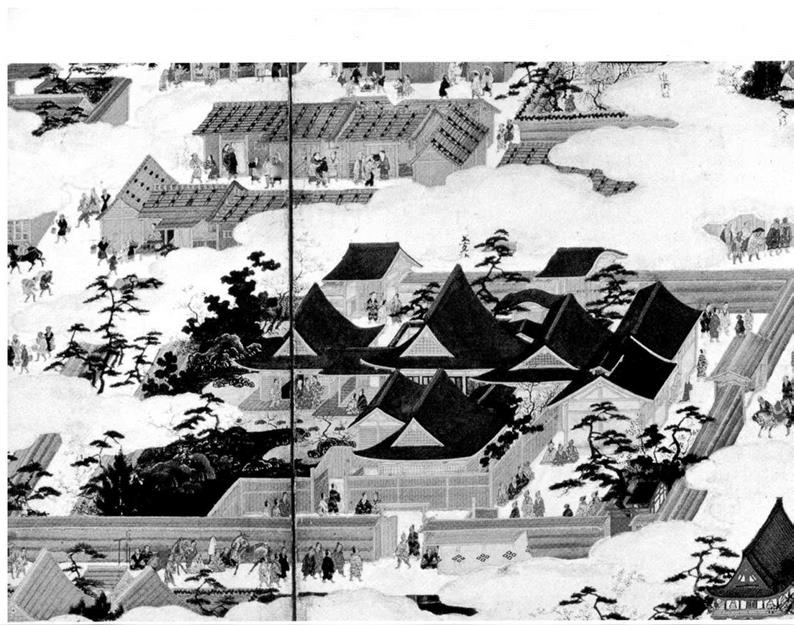|
T |
he next wave of continental cultural influence, following the importation of Tang culture in the Nara and early Heian periods, was that of the Song dynasty (960-1279) during Japan’s Muromachi period, when Chinese paintings and wares were imported in astounding quantities. Yoshida Кепко expresses the tenor of the times in this passage from his classic philosophical miscellany Tsurezuregusa (Essays in Idleness), written in 1330:
It is the height of foolishness that Chinese ships should make the dangerous journey over here crammed with cargoes of useless things.1
Chinese culture had been transmitted to Japan during the Nara and Heian periods in the form of “images” of the Tang capital and its palaces, whereas the culture imported during the Muromachi period took the form of goods. This bore a direct influence on Japanese residential architecture, where the oshi-ita decorative alcove (or tokonoma in its later form), chigaidana staggered shelves, and tsukeshoin built-in desk were constructed for the purpose of displaying Chinese paintings and wares. More indirectly, it led to the subdivision of the formerly open shinden main hall into rooms defined by fixed walls and sliding doors, the construction of ceilings and tatami mat-covered floors, and a shift from round to square posts. These features define the architectural style which came to be known as shoin-zukuri. This second wave of continental influence marked a radical reform in the history of Japanese residential architecture; this reform did not, however, extend to city planning.
By the close of the Heian period, Kyoto’s one-cho city – block grid had been subdivided into sites measuring one – fourth – and one-eighth-c/id. This degree of reduction in site size—what might today be called “miniaturization”— would naturally impact the scale and configuration of the architecture and gardens that a site could accommodate, as is evident in the folding screen paintings known as rakuchu rakugai-zu (scenes in and around the capital; Figure 15).
Over the course of the Kamakura period, the Tang- based prototype for the palace and garden had faded, although the custom of always basing composition on a model remained. The Heian palaces and gardens of Japan became the new prototype. The transition from shinden- zukuri to shoin-zukuri began with the north half of the residence. The shinden-zukuri style was at first retained in the south half, and the transformation to shoin-zukuri was gradual (Figure 16).
|
|||||||||
|
|||||||||
|

![]()

|
|
||
|
|||
|
|||
![]() 17 Schematic showing the division of the shinden into formal {hare) and informal (ke) halves, and into small rooms along the building’s north side.
17 Schematic showing the division of the shinden into formal {hare) and informal (ke) halves, and into small rooms along the building’s north side.
Sociopolitically, the medieval period saw the formation and development of a feudal society, and the transitional exchange of political power from the aristocracy to the warrior class. Zen Buddhism, also imported from China (where it is known as Chan), stressed self-reliance, discipline, and austerity—attributes that greatly appealed to the military consciousness. The leading aesthetic ideal of the middle ages was known as “yUgerT (mystery and depth), and like Zen, it was concerned with the true nature hidden behind the illusory aspects of the world. Yet despite these changing ideals, understanding and expressing the essence of nature remained the keystone of all the arts. In his poetic diary Oi no kobumi (The Records of a Travel – worn Satchel), written in 1688, Matsuo Basho looks back in history to masters who exemplified the highest attainments in their disciplines:
Saigyo in traditional poetry, Sogi in linked verse, Sesshu in painting, Rikyti in tea ceremony, and indeed all who have achieved real excellence in any art, possess one thing in common, that is, a mind to obey nature, to be one with nature, throughout the four seasons of the year.2
The shinden-zukuri garden was designed for ceremonial use. During the transitional period, however, this primary function was lost, and the garden became purely ornamental.



